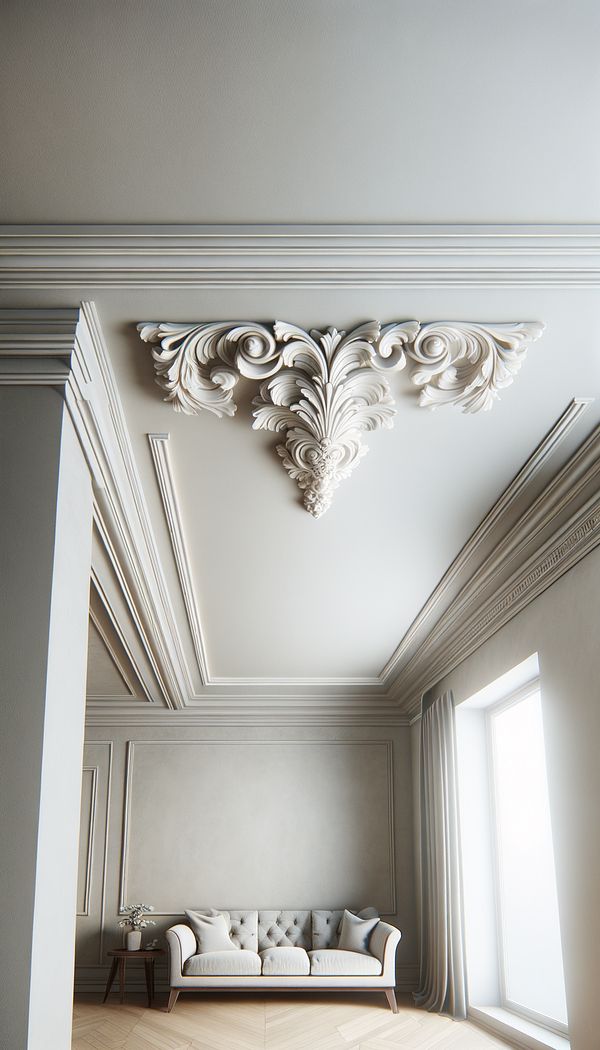What is Cornice?
A cornice is an ornamental molding that runs along the top of a wall or a building.
Description
In the realm of interior design, a cornice serves as more than just a decorative element; it's a pivotal architectural feature that can transform the overall look and feel of a room. Traditionally, cornices are crafted from plaster, wood, or polyurethane, and they run along the top edge of a wall where it meets the ceiling. This ornate molding can be simplistic or highly detailed, depending on the interior design style and aesthetic preferences.
Cornices can be found in a variety of settings, from historic buildings boasting elaborate designs to modern homes seeking a touch of elegance. They play a crucial role in concealing any gaps or imperfections where the wall meets the ceiling, providing a seamless transition between the two. Moreover, cornices can be utilized to enhance the room's proportions, making spaces feel taller or more intimate depending on their design.
The design and material of a cornice can greatly impact the ambiance of a room. For instance, a minimalist cornice may complement a modern interior design, while a richly detailed cornice could be the perfect match for a more traditional or classical setting. Ultimately, the choice of cornice can significantly influence the character and style of an interior space.
Usage
Cornices are commonly used in residential homes, office buildings, and historical landmarks. In residential settings, they can add a decorative touch to living rooms, dining rooms, and hallways. For commercial spaces, cornices might be used to enhance the architectural beauty of lobbies or conference rooms. Additionally, in the restoration of historical buildings, preserving or replicating original cornices is often a key aspect of the project to maintain the structure's historical integrity.
FAQs
-
Can cornices be painted?
Yes, cornices can be painted to match or complement the room's color scheme. Painting allows for further customization, enabling the cornice to blend seamlessly with the rest of the interior design.
-
Are cornices only used in traditional interiors?
No, cornices can be used in a variety of interior design styles, including modern and contemporary settings. The key is choosing a cornice design that aligns with the overall aesthetic of the space.
-
How are cornices installed?
Cornices are typically installed by attaching them to the top of walls using adhesive, nails, or screws. Depending on the material, professional installation may be recommended to ensure a secure and aesthetic fit.
-
Do cornices have any practical benefits?
Yes, besides their decorative appeal, cornices can help conceal uneven edges where walls meet ceilings, and in some cases, they can even help improve acoustics in a room by disrupting sound waves.
Practical Application
When selecting a cornice for your space, consider the room's existing architectural features and design style. Opt for a cornice that complements the room's proportions and enhances its aesthetic appeal. Additionally, ensure that the material and design of the cornice align with the overall theme and functionality of the interior design.
-
Architectural Elements199 articles
-
Design Styles478 articles
-
Decorative Techniques322 articles
-
Construction & Building86 articles
-
Wall Treatments & Finishes157 articles
-
SeersuckerSeersucker is a puckered, lightweight fabric commonly used in a variety of interior design applications.
-
Shield BackA shield back is a specific design of chair back that resembles the shape of a shield.
-
BattenA batten is a narrow strip of material, typically wood, used in construction and interior design.
-
LatticeLattice is a framework consisting of a crisscrossed pattern of strips of material.
-
StoveA stove is a cooking appliance designed to cook or heat food.
